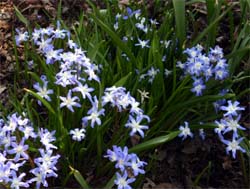
Chionodoxa forbesii is commonly called Glory-of-the-Snow because it blooms early enough that its flowers sometimes poke right out of the snow. The genus name is derived from the Greek words chion, meaning snow and doxa meaning glory. This small bulb, native to western Turkey, is closely related to (and was formerly included in) the genus Scilla. Like scilla, it can spread and naturalize under the right conditions and is hardy in zones 3-8.
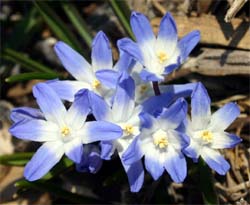
The small, upward-facing flowers are pale blue with a white center, making them appear almost glassy or translucent. The star-shaped flowers have six petals that spread nearly flat to ½-¾ inch wide. Each bulb produces a raceme of 5-10 flowers on brownish stems. The flowers sprays can be cut for tiny bouquets. The clumps of mid-green, strap-like leaves die back in the summer. The plants grow to about 6″ tall.
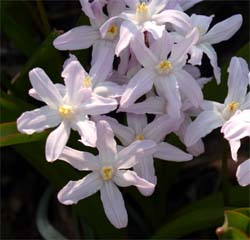
This bulb is sometimes still offered under its former names of C. luciliae or C. gigantea. In addition to the blue-flowered species, there are the varieties ‘Alba’ with white flowers and ‘Pink Giant’ with pink flowers. This latter was given the “Outstanding Plant Award” by the Royal General Bulbgrower’s Association in Holland. It blooms about a week later than the blue type and is more of a lavender than true pink and the flowers are smaller than the blue ones (the name Giant probably refers to the former species name C. gigantea, not the size).
Plant Chionodoxa in the fall, locating them in full to partial sun in well-drained soil. They can be planted under deciduous trees as the bulbs will finish blooming before the trees leaf out. Place the bulbs about 3″ apart and 2-4″ deep.
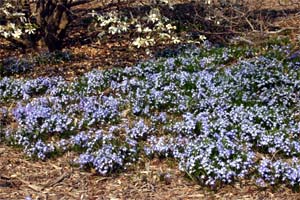
These small bulbs are good in perennial beds or for naturalizing in rock gardens or woodlands and combine well with daffodils, grape hyacinth, crocus and other small spring bulbs.
They can also be naturalized in a lawn, as long as mowing is postponed until the foliage begins to die back (about 5-6 weeks) or if the mower blade is set high enough to avoid removing too much of the small leaves. They are unaffected by juglone, so can be planted under walnut trees. Although they are short because they are up and blooming so early in the spring (before many other perennials are very advanced in their growth), they do not have to be restricted to just the front of a border. They can be used around hostas as they flower well before the hosta leaves unfurl.
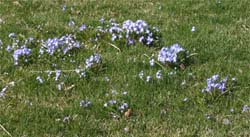
Chionodoxa can be propagated by dividing the bulbs or from seed. They self sow readily under ideal conditions. To collect seeds, allow pods to dry on the plant, then break open pods to collect the seed. Collected seed can be direct sown outdoors in fall; if sown indoors they must be stratified to germinate.
– Susan Mahr, University of Wisconsin – Madison
Ask Your Gardening Question
If you’re unable to find the information you need, please submit your gardening question here:





 Aster, Symphyotrichum spp.
Aster, Symphyotrichum spp. Fascinating Fasciation
Fascinating Fasciation Alternatives to Lawn: Groundcovers
Alternatives to Lawn: Groundcovers Marigolds
Marigolds


